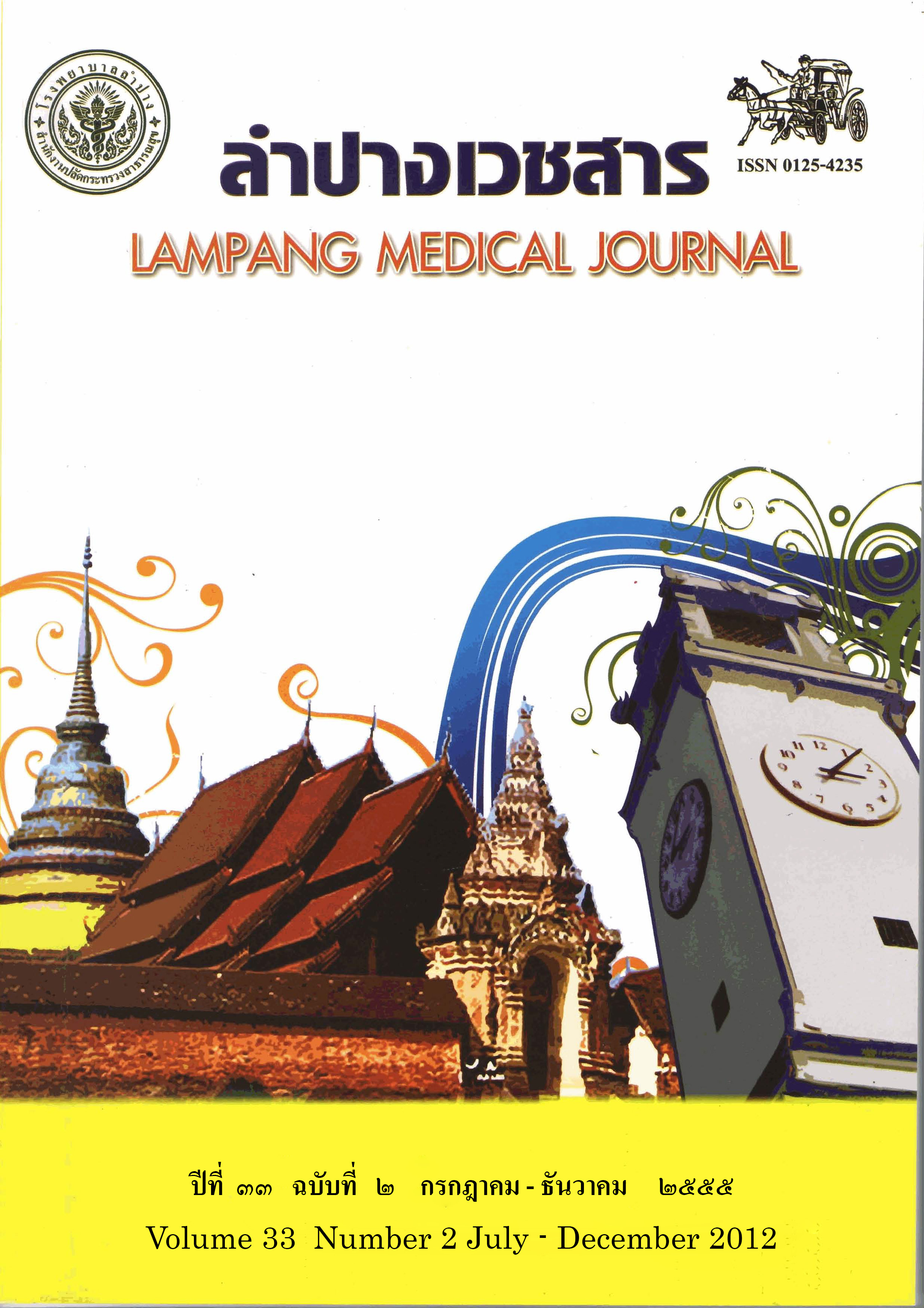Applying the Lean Production System to Improve Stroke Fast Track Care in Lampang
Main Article Content
Abstract
Background : Currently the standard treatment for adult patients with acute ischemic stroke within 4.5 hours of onset of symptoms is intravenous thrombolysis with recombinant tissue plasminogen activator (rtPA). It should be given within 60 minutes of arrival in the emergency department. In July 2010, Lampang Hospital began a stroke fast track program, employing Lean/Toyota production system principles to improve wait times and quality of care.
Objective: To compare the process cycle efficiency, indicators, treatment outcome and complication before and after program implementation.
Material and method: An interrupted time, observational study was conducted on 62 patients with acute ischemic stroke who receiving intravenous rtPA at emergency department of Lampang Hospital between June 2008 – February 2011. Twenty-eight patients were classified into pre-Lean group and 34 were in post-Lean group. Timing for each step, complication, clinical
outcome and mortality rate were recorded. The process cycle efficiency (PCE) and Thailand hospital indicator project (THIP) were calculated and compared between groups by using Fisher’s exact and t-test.
Results: The mean age was 63.6 ± 12.7 years (range, 38-91) and 51.6 % was female. The mean door-to-needle time decreased from 75.0 ± 22.4 minutes to 53.0 ± 20.5 minutes (p<0.001) and PCE improved from 18.0% to 24.7% (p<0.001). Percentage of patients receiving rtPA within 60 minutes of arrival (THIP) improved from 32.1% to 88.2% (p<0.001). The post-Lean group had lower incidence of symptomatic intracranial hemorrhage (5.9% vs 7.1%, p=1.000), mortality rate at 3 months (8.8% vs 10.7%, p=1.000) and higher favorable outcome (44.1% vs 21.4%, p=0.105)
Conclusion: Applying Lean/Toyota production system principles to stroke fast track system in Lampang Hospital could improve the process cycle efficiency, door-to-needle time and THIP. Major complications and mortality rate were not significantly reduced.
Article Details

This work is licensed under a Creative Commons Attribution-NonCommercial-NoDerivatives 4.0 International License.
บทความที่ส่งมาลงพิมพ์ต้องไม่เคยพิมพ์หรือกำลังได้รับการพิจารณาตีพิมพ์ในวารสารอื่น เนื้อหาในบทความต้องเป็นผลงานของผู้นิพนธ์เอง ไม่ได้ลอกเลียนหรือตัดทอนจากบทความอื่น โดยไม่ได้รับอนุญาตหรือไม่ได้อ้างอิงอย่างเหมาะสม การแก้ไขหรือให้ข้อมูลเพิ่มเติมแก่กองบรรณาธิการ จะต้องเสร็จสิ้นเป็นที่เรียบร้อยก่อนจะได้รับพิจารณาตีพิมพ์ และบทความที่ตีพิมพ์แล้วเป็นสมบัติ ของลำปางเวชสาร
References
The National Institute of Neurological Disorders and Stroke rt-PA Stroke Study Group. Tissue plasminogen activator for acute ischemic stroke. N Engl J Med 1995;333(24):1581-7.
Hacke W, Kaste M, Bluhmki E, Brozman M, Dávalos A, Guidetti D, et al. Thrombolysis with alteplase 3 to 4.5 hours after acute ischemic stroke. N Engl J Med 2008;359(13):1317-29.
Jauch EC, Cucchiara B, Adeoye O, Meurer W, Brice J, Chan YY, et al. Part 11: adult stroke: 2010 American Heart Association guidelines for cardiopulmonary resuscitation and emergency cardiovascular care. Circulation 2010;122 Suppl 3:S818-28.
Suwanwela NC, Phanthumchinda K, Likitjaroen Y. Thrombolytic therapy in acute ischemic stroke in Asia: The first prospective evaluation. Clin Neurol Neurosurg 2006;108(6):549-52.
Graban M. Lean hospitals: improving quality, patient safety, and employee engagement. 2nd ed. Boca Raton: Taylor & Francis;2011. p.17-29.
Ng D, Vail G, Thomas S, Schmidt N. Applying the Lean principles of the Toyota Production System to reduce wait times in the emergency department. Can J Emerg Med 2010;12(1):50-7.
Melanson SE, Goonan EM, Lobo MM, Baum JM, Paredes JD, Santos KS, et al. Applying Lean/Toyota production system principles to improve phlebotomy patient satisfaction and workflow. Am J Clin Pathol 2009;132(6):914-9.
Rutledge J, Xu M, Simpson J. Application of the Toyota Production System improves core laboratory operations. Am J Clin Pathol 2010;133(1):24-31.
Goldstein LB, Samsa GP. Reliability of the National Institutes of Health Stroke Scale. Extension to non-neurologists in the context of a clinical trial. Stroke 1997;28(2):307-10.
Sulter G, Steen C, De Keyser J. Use of the Barthel index and modified Rankin scale in acute stroke trials. Stroke 1999;30(8):1538-41.
Yamaguchi T, Mori E, Minematsu K, Nakagawara J, Hashi K, Saito I, et al. Alteplase at 0.6 mg/kg for acute ischemic stroke within 3 hours of onset. Stroke 2006;37(7):1810-5.
Nakagawara J, Minematsu K, Okada Y, Tanahashi N, Nagahiro S, Mori E, et al. Thrombolysis with 0.6 mg/kg intravenous alteplase for acute ischemic stroke in routine clinical practice. Stroke 2010;41(9):1984-9.
Toyoda K, Koga M, Naganuma M, Shiokawa Y, Nakagawara J, Furui E, et al. Routine use of intravenous low-dose recombinant tissue plasminogen activator in Japanese patients. Stroke 2009;40(11):3591-5.
Dharmasaroja PA, Dharmasaroja P, Muengtaweepongsa S. Outcomes of Thai patients with
acute ischemic stroke after intravenous thrombolysis. J Neurol Sci 2011;300:74-7.
Ueshima S, Matsuo O. The differences in thrombolytic effects of administrated recombinant t-PA between Japanese and Caucasians. Thromb Haemost 2002;87(3):544-6.
Wahlgren N, Ahmed N, Dávalos A, Ford GA, Grond M, Hacke W, et al. Thrombolysis with alteplase for acute ischaemic stroke in the safe implementation of thrombolysis in strokemonitoring study (SITS-MOST): an observational study. Lancet 2007;369(9558):275-82.
Hacke W, Kaste M, Fieschi C, von Kummer R, Dávalos A, Meier D, et al. Randomised double-blind placebo-controlled trial of thrombolytic therapy with intravenous alteplase in acute ischaemic stroke (ECASS II). Lancet 1998;352(9136):1245-51.


